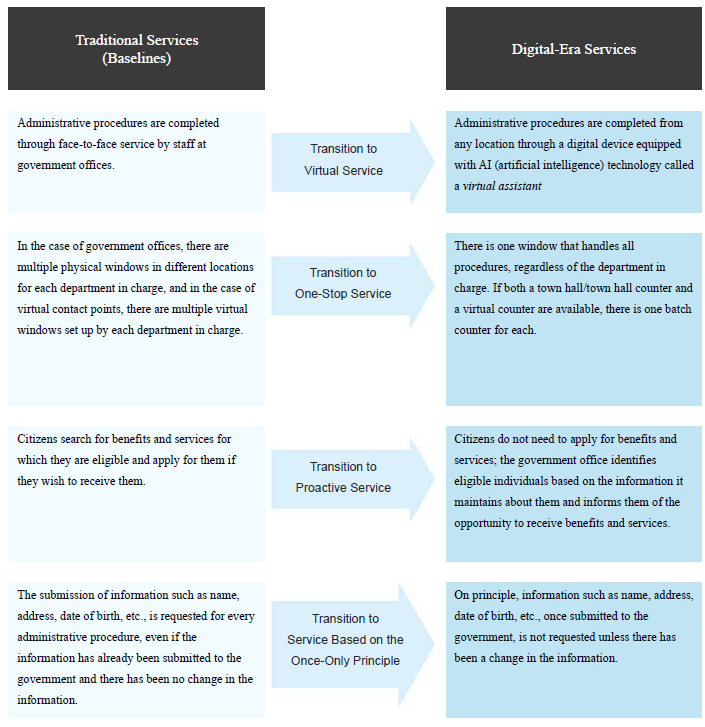I. Research Background: Global Moves Towards “Zero Bureaucracy and Invisible Government”
Ten years ago, in 2015, the Estonian prime minister, Taavi Rõivas, said in a speech, “The Estonian vision for the future of digital government is simple: We should aim for zero bureaucracy and invisible government, as the slogan goes”.1 Borrowing the prime minister’s words, “zero bureaucracy and invisible government”, this study defines the former as a situation where citizens do not have to do anything to receive government services and the latter as a situation where citizens have no physical point of contact with the state, as shown in Figure 1.

Figure 1. Definitions of zero bureaucracy and invisible government
The study sheds light on the transition to (1) one-stop service, (2) proactive (push) service, (3) virtual service, and (4) service based on the once-only principle, as representative reforms of the digital era (see Figure 2). Although the services other than virtual service can be realized without digital technology, this paper refers to all four as “digital-era services” because they are often facilitated by the use of digital data and advanced digital technology. The paper also refers to the services before the transition as “traditional services”, and points out that the transition from traditional services (on the left in Figure 2) to the corresponding digital-era services (on the right) will bring us closer to a world of “zero bureaucracy and invisible government”.

Figure 2. Changes in the Citizen-State Interface, Brought About by a Transition from Traditional to Digital-Era Services
Various governments are making the abovementioned transitions, albeit at different speeds. Among the leading nations is Estonia, where administrative procedures other than divorce and marriage can be completed digitally, and child benefits are provided proactively. The EU’s e-Government Action Plan 2016-2020 requires the signatory countries to adhere to the principles of digital-by-default and the once-only principle. In Japan, digital-era services are mentioned in official documents, such as the Priority Plan for the Realization of a Digital Society.
If a world that is closer to “zero bureaucracy and invisible government” becomes a reality, it will change the relationship between citizens and government. Moreover, concepts and theories such as street-level bureaucracy and administrative burden, which have been extensively studied in the field of public administration, might become moot, or at least in need of revision.
II. Research Questions and Hypotheses
The study asked whether or not people want to see a transition from traditional services to digital-era services. In addition to the abovementioned four services, the study added one more, “virtual-plus-physical service”, whereby virtual service is introduced while physical-counter service is retained, and it tested the following hypotheses regarding the five forms of service:

While it might seem that the transition to digital-era services would make life easier for citizens and that everyone would want them, there are reasons why this might not necessarily be the case, and most of the causal relationships involved were hypothesized to be non-directional, either positive or negative. Among the many positive reasons mentioned in the study, digital-era services not only relieve the burden of traditional services, but also achieve standardization and fairness in the treatment of citizens due to the absence of human intervention. However, while this would seem to have a positive effect on the favourability of public administration, the idea of fairness may not be welcome to vulnerable members of society, who may want special consideration rather than equal treatment, a possibility noted in a study by Suzuki and Demircioglu (2021)2.
III. Someone Who May Be Left Behind Might Still Prefer to See a Transition
In digital transformation discourse, Japan is not alone in expressing the aspiration to “leave no one behind”, so that everyone can enjoy the benefits of digitization, and to give attention to those who may be left behind, such as the elderly and people with low digital literacy. However, what is often forgotten in such discourse is that feelings toward digital-era services are different when the services are compared to traditional services. Even those who are not especially accepting of digital-era services per se might be willing to support a transition to improve on traditional services; conversely, people who like digital-era services might still prefer the status quo.
For example, the elderly are often assumed to have low digital literacy compared to younger generations, but they may, on average, be more than happy to see a transition to virtual services, as that would save them from having to travel to a distant city hall, which can be physically demanding.
To determine whether citizens want reform, therefore, it is necessary to look at their feelings toward digital-era services in a comparative way.
IV. Research Methodology
This study involved a choice-based conjoint (CBC) experiment conducted in March 2023, using an Internet panel. The advantage of a CBC experiment is that it simultaneously estimates the causal effects of a transition to the five digital-era services on the same outcome – the favourability of public administration – with high internal validity. As a result, CBC analysis makes it possible to compare the relative importance of different digital-era services and to suggest priorities. The study collected 938 responses from individuals aged 18-79 residing in Japan, reflecting the regional, gender, and age distribution of the 2020 Census. Since this was an Internet survey, there was a concern that the target population might have minimal Internet access and that there would be an insufficient number of “digitally illiterate” respondents; however, the survey revealed that many respondents lacked confidence in their digital literacy, even though they were able to complete the Internet survey.
V. Results and Implications
The main findings are as follows:
- In general, the transition to one-stop service, virtual-plus-physical service, proactive service, or service based on the once-only principle would be welcomed.
- Of the four services just mentioned, it was the transition to once-only service that had the greatest positive impact on administrative favourability, followed by the transition to proactive service.
- Of the four services, one-stop service had the smallest positive impact on favourability, even though it was mentioned more frequently in Japan’s Priority Plan for the Realization of a Digital Society.
- The study found a negative impact on attitudes toward the transition to virtual-only services for those with disabilities and those who were not confident about their digital literacy.
- Other than the above, the study found no negative impact for a transition to digital-era services on administrative favourability, even for those generally considered vulnerable in the context of digitization, including the elderly, those with physical and psychological difficulties, and those who are not confident in their digital literacy.
- As for hybrid services, those with disabilities, those who are very busy, and those who lack confidence in their digital literacy welcomed the move to virtual-plus-physical services, but not as much as their counterparts.
While the results of the statistical analysis in this study do not reveal exceptions or the special circumstances of some citizens, and while the limitations of external validity should be noted, the results generally indicate that digital-era services are welcome.
Among the respondents, there was a particular demand for the transition to the once-only principle. Although there are moves such as the EU’s digital-by-default, this study suggests that at least at this point in Japan, people would like to see a hybrid arrangement, where virtual and physical windows are available in tandem, rather than a complete shift to virtual services.
The disadvantaged and those who lack confidence in their digital literacy showed an aversion to virtual-only service, which should be taken note of in efforts to design inclusive and user-centric administrative services.
1 Republic of Estonia Government. (2015). Prime Minister Rõivas’s speech at Digital 5 network event Tallinn. https://valitsus.ee/en/news/prime-minister-roivass-speech-digital-5-network-event-tallinn
2 Suzuki, K., & Demircioglu, M. A. (2021). Is impartiality enough? Government impartiality and citizens’ perceptions of public service quality. Governance, 34(3), 727-764.
Publication information
Aoki, N. (2025). En Route to “Zero Bureaucracy and Invisible Government”: A Conjoint Analysis of the Effects of Transforming the State-Citizen Interface on the Favourability of Public Administration in the Digital Era. Asia Pacific Journal of Public Administration https://doi.org/10.1080/23276665.2025.2478554






